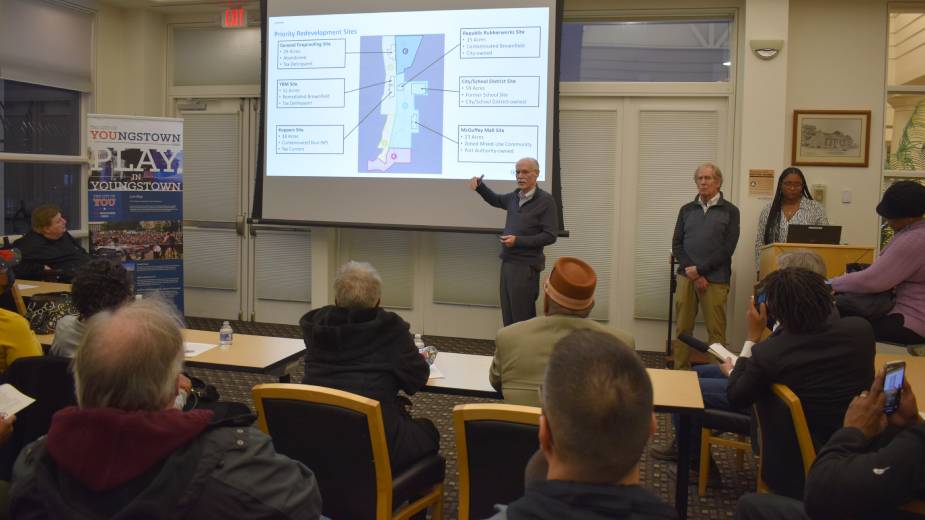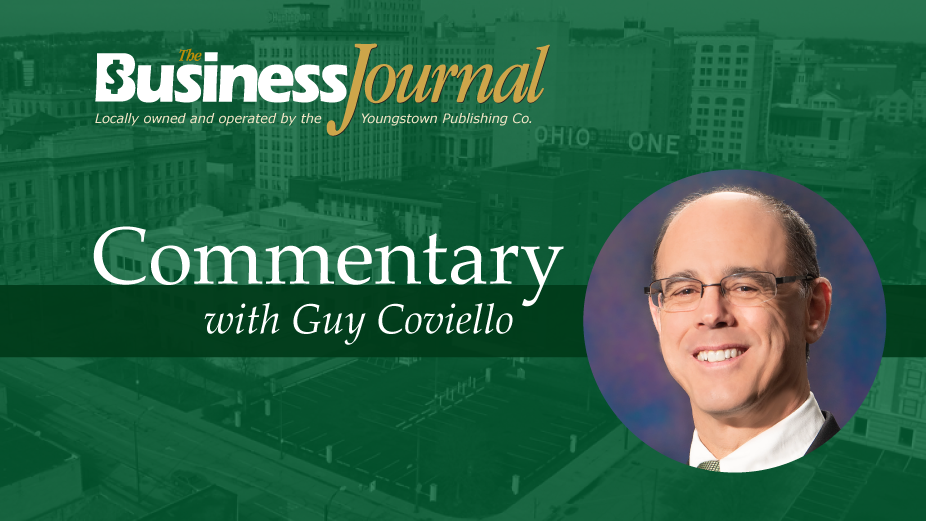City, Consultants Outline Crab Creek Opportunities
YOUNGSTOWN, Ohio – Keys to capitalizing on development opportunities in the Crab Creek corridor include addressing blight and improving infrastructure, a consultant said.
City officials joined a representative of AECOM, the Cleveland-based consultant it engaged to conduct a study of the East Side industrial corridor, at a meeting Tuesday evening at the Public Library of Youngstown & Mahoning County’s East Library.
During the meeting, the city officials and consultants unveiled the results of the $100,000 study of the industrial area, which was paid for using an $80,000 U.S. Economic Development Administration grant and city funds.
“The key opportunities really lie in identifying the priority redevelopment sites and making sure that the infrastructure that serves those sites is workable and is attractive to outside developers,” said Jeff Homans, AECOM vice president.
The area, which historically has been identified by the kinds of industries that were dominant a century ago, can be defined as a future industrial redevelopment area with “greener industries that are more consistent with the kind of development” seen taking place in industrial parks and other places around the county, he said.
According to an analysis by AECOM, the Youngstown region could see an influx of up to 43,000 jobs in the next decade and up to 48 million square feet of new industrial development. While not all of those jobs will come to Youngstown, the goal is to ensure the city “gets its fair share of those jobs, which will be occurring,” he said.
The planning process at work is similar to that employed when Trumbull County communities and businesses collaborated to develop a plan for the “Golden Triangle,” which AECOM also was involved with, he said.
Five Objectives
The plan being developed for the corridor will have five objectives: defining and buffering its industrial and residential zones; improving road and highway infrastructure serving the district; prioritizing the district’s major redevelopment sites; unlocking potential tributaries to the creek; and specifying implementation strategies and action steps.
“This is really about a rebirth,” Homans said.
The study identified several key industrial sites, including the 29-acre former General Fireproofing property, an abandoned, tax-delinquent site.
“It’s a significant blighting influence,” said Hunter Morrison, city planning consultant.
Other properties that represent development opportunities include the 15-acre Republic Rubber site, which requires environmental remediation; and the former McGuffey Plaza, which the Western Reserve Port Authority acquired in 2022 and is working to remediate using American Rescue Plan funding from the city.
“The sites have to look better,” Homans said. “If you think of somebody flying in from Los Angeles that’s looking for a 20-acre site for a fabricating plant and they see [blighted properties], they’re going to be discouraged. The visual character of the neighborhoods needs to be upgraded.”
Demolishing the abandoned properties and cleaning them up can help reverse the perception of blight and the general impression of the area, Morrison said. Even though there are successful businesses and longstanding homeowners in the area, many people driving though there don’t get that impression because of the condition of some of the properties in the neighborhood.
One of the potential infrastructure improvements identified in the study was taking advantage of the abandonment of residential properties in the blocks adjacent to the industrial area along the corridor to create a buffer, Morrison said.
Potential roadway upgrades included improvements to the convergence of Hubbard Road, Belle Avenue and Albert Street, which creates confusion for cars and trucks navigating out of the district and represents an inefficient use of land, and redefining Logan and Andrews avenues as truck routes.
Another priority the study identified was addressing the “emerging entertainment area” at the southern end of the district, a mixed-use district where Youngstown Flea and Penguin City Brewing Co. both took over former industrial properties but where Brilex Industries, Valley Goods and other companies operate as well.
Configuring the road to accommodate the increasing pedestrian traffic and parking for people visiting the venues while protecting the interests of the existing industrial businesses is a challenge, Homans acknowledged.
“It’s still very much industrially important, and it’s also the gateway to the Crab Creek corridor,” he said.
Mark Ragozine, economic development project manager at Eastgate Regional Council of Governments, outlined potential sources of funding for any projects, including EDA, Appalachian Regional Commission and the All Ohio Future Fund, a $750 million fund to get sites ready for development.
Concerns
One proposal that raised concerns by one business operator in attendance was potential changes to the Madison Avenue expressway to make it a low-speed boulevard. Eastgate Regional Council of Governments is in early stages of seeking funding for a study.
“I don’t want to see that Madison Avenue expressway cut off,” said Mike Kovach, president of City Machine Technologies.
Both the Madison expressway proposal and a plan to connect the East Side to Interstate 80 are in their infancy, Ragozine said. He also said that if a project isn’t deemed to be advantageous, then it won’t go forward.
“The benefit of a feasibility study is that study can tell you that this isn’t a good idea,” he said. “We’re not in the business of doing things that people don’t want.”
Taylor Jones, a community projects manager for the city and a Harvard Bloomberg City Hall Fellow, unveiled a website where she said the city would provide regular updates on the plan’s progress and solicit input from interested parties.
Samantha Yannucci, city planning consultant, said the city’s objective is for the district to develop with the community and to ensure that the community’s interests are considered during the entire planning process, with goals including improving connectivity for East Side residents.
“This will be the first of many conversations,” she said.
Both Kovach and Mark Peters, director of engineering at Fireline Inc., who also provided input in the study, said they were satisfied overall with what was presented.
“What they have here is a good starting point,” Peters said. He would like for there to have been more said about safety because that affects his company’s ability to retain and attract employees.
“There’s a few lots we’d like to see cleaned up. Some people don’t respect the property on Andrews Avenue like we do,” Kovach said.
James Crum, a North Side resident who has parents he regularly cares for on the East Side, attended the meeting to get clarification about what is being considered for the Crab Creek area. He said he would like to see blight remediation in what he considered a “vibrant, proud, beautiful community” when he was growing up there.
“It could only be a start for something better, but at least it’s a start,” he said.
Mayor Jamael Tito Brown emphasized that improvements won’t happen immediately.
“The process is not an overnight process,” he said.
“What needs to happen is that the stakeholders and all of the governmental entities that are participating as stakeholders need to keep this alive. They need to stay with the plan,” Homans said. “Implementation is not something that happens in the course of a single administrative period. It’s something that takes place over multiple years.”
Pictured at top: Hunter Morrison, left, speaks during Tuesday’s meeting. With him are Jeff Homans and Taylor Jones.
Copyright 2024 The Business Journal, Youngstown, Ohio.



